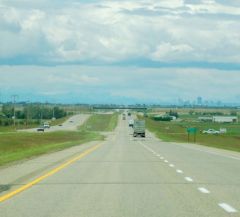Those of us who drive cars typically have our favourite road tunes. One of my favourites is Led Zeppelin’s Kashmir, off the Physical Graffiti album. Any self-respecting, Zeppelin-loving driver knows a particularly sublime feeling: slowly pushing on that gas pedal to the beat of Jimmy Page’s rising, signature chord progression riff in Kashmir, watching that speedometer creep up to 90 klicks an hour, then 100, 110, 120…. “I am a traveller of both time and space, to be where I have been….”
 Okay, my little drive down classic rock memory lane is over. As a guy who thinks a lot about optimal energy use I’ve learned that ripping up the TransCanada highway at 120 km/h or higher is not smart driving. So I’m happy that today in Halifax travellers of a different sort are starting a cross-Canada roadtrip that aims to set a national record for the least amount of fuel used to drive to Vancouver, and teach us lead-footed drivers a better way. Shell’s Smarter Driver Challenge is designed to show how changing driving styles can dramatically improve fuel mileage while still allowing us to enjoy getting from point A to B.
Okay, my little drive down classic rock memory lane is over. As a guy who thinks a lot about optimal energy use I’ve learned that ripping up the TransCanada highway at 120 km/h or higher is not smart driving. So I’m happy that today in Halifax travellers of a different sort are starting a cross-Canada roadtrip that aims to set a national record for the least amount of fuel used to drive to Vancouver, and teach us lead-footed drivers a better way. Shell’s Smarter Driver Challenge is designed to show how changing driving styles can dramatically improve fuel mileage while still allowing us to enjoy getting from point A to B.
And as part of the challenge, yours truly has been invited to drive the leg from Medicine Hat to Calgary, Alberta, on June 20th, for which I will undergo behind-the-wheel training designed to make me a more efficient driver.
From skepticism to interest
When initially invited to participate, I was skeptical. Sure, helping people cut down on the amount of gasoline they use is a worthwhile cause, but I wondered if it would it distract attention from more pressing issues around making our mobility systems more sustainable — such as land use planning, support for public transit, tougher fuel efficiency standards, reduced packaging in freight, and mechanisms to drive down upstream and refining emissions. Will these driving techniques work, and would they even be adopted, given our culture’s apparent need for speed? Is there more to it than just driving slower? And, if we use less fuel, will we simply drive more?
But then I did some math.
If one in twenty Canadian drivers were to drive 20 per cent more efficiently, it would reduce the greenhouse gas emissions from driving by about 800,000 tonnes per year. This is equivalent to taking 207,740 cars and light trucks off the road. If half of Canadian drivers adopted more-efficient driving techniques — say as part of a driving license training program — the savings would be on the order of 8 million tonnes of greenhouse gases per year. To get the equivalent greenhouse gas reduction we’d have to shut down a large coal-fired power plant, or spend 6–7 billion dollars on carbon capture and storage projects. That sure caught my interest.
Enter the experts
Still, the question remained: can training experienced drivers — or stubborn drivers like me who think they drive just fine, thank you — to drive differently really reduce emissions? Apparently, yes.
Australians Helen and John Taylor together hold 89 world records for fuel-efficient driving (who knew that there were world records for fuel-efficent driving!). These veteran drivers say they have reduced their personal driving-related carbon emissions by 30 per cent using a set of simple techniques that anyone can learn. They offer training programs around the world, including the one I’m participating in. I will be trained behind-the-wheel by the Taylors, with the goal of increasing my fuel efficiency by 20 per cent.
Why we’re working with Shell on the Smarter Driver Challenge
Given that the opportunity is significant and the techniques sound doable, how does smarter driving fit within the broader suite of things we need to do to tackle climate change?
This question will drive how we at the Pembina Institute participate with Shell’s Smarter Driver tour. Our primary role is to provide an arm’s length analysis of the results, to determine if there are meaningful reductions in fuel use, and if the techniques are consistent with how people are actually willing to drive.
I'm especially curious about this last point, on a personal level. Sure, like most people, I’m all for reducing my fuel costs and emissions, and maybe being the chief executive energy geek of the Pembina Institute gives me an extra bit of motivation. But I also don’t want to have to draft right behind a big 18-wheeler on the highway to do so. I know the Taylors propose something different, and soon I’ll find out exactly what and whether or not it works for me.
My colleagues and I will also try to understand the potential impact for Canada if this type of training were to be scaled up. What if policies were in place to have Canadian drivers trained in efficiency techniques as a stipulation to renew drivers licenses? Or, as incentives for lower insurance rates or parking ticket forgiveness? Just some ideas.
More broadly, we will analyze potential savings in terms of fuel, greenhouse gas emissions and money from a suite of behavioural choices. Those choices include selecting a more fuel-efficient, hybrid or electric vehicle, leaving the car at home and taking transit, riding a bike or simply living closer to work. The reality is that we need to get all hands on deck — or in this case, more feet eased off the pedal.
The bigger picture
The reality is that we need to transition from transportation based solely on fossil fuels to mobility that is low-carbon and sustainable. This includes investing more in public transit infrastructure, better urban planning, getting more electric vehicles on the road while integrating them with smart grids powered by clean electricity, along with policies to reduce emissions from freight. However, many of these technology and infrastructure solutions take years. We need to find ways to reduce our carbon impacts now if we’re to avoid dangerous climate change.
More effective regulation for our cars and trucks is a policy solution that Pembina promotes, and our preliminary analysis to date leads us to think that smarter driving is potentially another way to see immediate savings in carbon emissions and cash. We’ll have more answers later this summer, so stay tuned — and in the meantime check out my blogs, tweets and driving tune recommendations from the road.
We thank Shell for bringing the Pembina Institute along for the ride and I look forward to heading to Medicine Hat later this month to do my own hands-on investigation. I’ll still “get Led out” along the way, but this time I plan on leaving the lead foot at home.





